This article may contain affiliate links. Please see our affiliate disclaimer in the footer menu for more information. Thank you for your support!
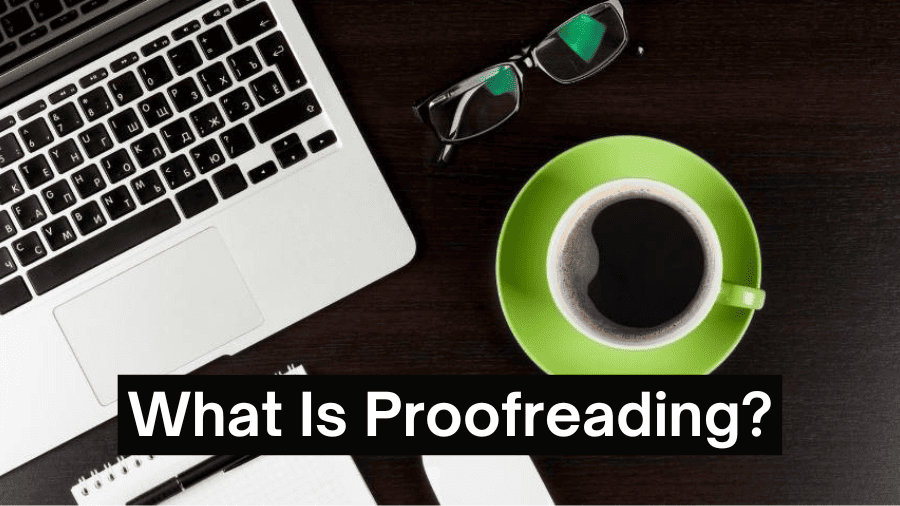
What is proofreading? This seemingly simple question often receives a variety of answers. As a trained proofreader with experience in the field, I can help you understand what constitutes proofreading.
Proofreading is the process of carefully reviewing the final draft of a text to find and fix errors and inconsistencies in grammar, capitalization, punctuation, spelling, and formatting. Proofreaders also correct problems with word usage and repeated or omitted words.
Nowadays, proofreading has a different meaning from what it means in the publishing industry alone. To add to the confusion, the term often gets mixed up with other terms like copyediting and editing.
Let’s clarify the confusion so we can understand what proofreading entails and how it fits into the editorial process.
What Is Proofreading?
To get a solid definition for proofreading, let’s turn to one of the most authoritative sources: The Chicago Manual of Style (CMOS).
CMOS is the go-to style guide in the US book publishing industry.
“Proofreading is the process of reading a text and scrutinizing all of its components to find errors and mark them for correction.”
– The Chicago Manual of Style
And here’s a more concise definition:
“to read and mark corrections in (something, such as a proof)”
– Merriam-Webster.com Dictionary
Although this last definition couldn’t be more straightforward, we have differing opinions about how to define proofreading.
It’s time to find out how this conundrum originated.
Why the Term Proofreading Is So Darn Confusing
People get confused about what proofreading involves because we sometimes use the terms proofreading and editing synonymously. But they aren’t synonymous!
Another reason for the confusion is that some people think of proofreading in a more traditional sense. They consider it to be a process that takes place in the publishing industry, where proofreaders work with typeset documents.
However, others think about proofreading in fields where typeset pages don’t come into play.
Proofreading in the Publishing Industry
Let’s discuss a proofreader’s role in the publishing industry.
Proofreaders in publishing companies compare the proof (the typeset document) to the copyedited document to verify that all the copy editor’s corrections are appropriately implemented.
They also check the proof against the copyedited version to ensure no errors were introduced during formatting and printing and that all design specifications are followed.
Fun fact: The term proofreader came about because the eagle-eyed folks in publishing houses would essentially “read” the “proofs.” 😊
Greater Focus on Formatting Fumbles
Catching formatting issues is a primary concern for proofreaders in the publishing industry.
They also look for spelling, punctuation, capitalization, and grammar errors that slipped through the cracks during previous editing stages.
They used to mark these mistakes on a hard copy with a red pen, using standard proofreaders’ marks.
Today it’s much more common for proofreaders to work on-screen with electronic documents and use PDF markup tools to pinpoint errors.
Here’s an excellent video from Editors Canada that explains the traditional proofreading process:
What Are Proofreaders’ Marks?
Proofreaders’ marks (aka proofreading marks) are unique abbreviations and symbols used to show how to fix minor errors in a typeset text.
In US English, the primary proofreading marks are divided into three categories:
- operational signs (mainly to show formatting problems)
- typographical signs (primarily to indicate proper font)
- punctuation marks (to locate missing punctuation)
I wrote an article about the extent to which proofreading marks are still used, in case you’re curious. It includes a video featuring some of the most common proofreading symbols.
Proofreading When Proofs Aren’t Involved
Outside of the publishing industry, proofreaders typically work directly with the author of a text. The author sends them a Microsoft Word document or a Google Doc. In this scenario, no proofs are involved.
Less Focus on Formatting Faux Pas
Proofreaders have fewer formatting fumbles to fix with content that isn’t typeset.
Widows and Orphans Are No Longer a Concern
Without a typeset text, widows and orphans are no longer considerations.
Widows and orphans are short lines of text that have been separated from the paragraphs they belong to.
They make the writing on a page look unbalanced.
When you see a page that begins with the last part of a sentence from the previous page’s paragraph, that’s a widow.
And when you see a page that ends with the first little part of a new paragraph—that’s an orphan.
Widows and orphans are little lines that have strayed from the paragraph they belong to like lost lambs that have strayed from their flock.
Other Formatting Issues That Fall Away
Proofreaders no longer need to worry about bad word breaks.
And they don’t need to look for blurry type that’s hard to read or sections of text that appear darker or lighter than surrounding parts.
Nor do they need to be concerned that facing pages are in alignment.
Looking at an open book, the page on the left is known as the verso, and the page on the right is called the recto.
Wouldn’t it feel weird if you were reading a book and the text ended at a different place on each page?
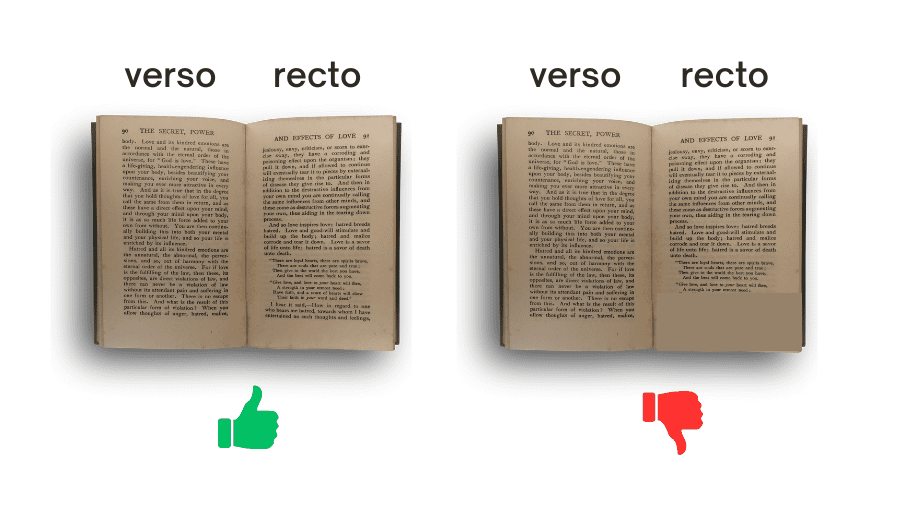
However, even if proofreaders aren’t working with typeset pages, they still have to ensure that content is well formatted so it’s visually appealing and easy to read.
For example, they ensure that the correct amount of space appears between words, sentences, and paragraphs and that indentations are properly aligned.
Working with Track Changes and the Suggesting Feature
When a proofreader corrects an MS Word document, they use Track Changes. And when working in Google Docs, they utilize the Suggesting feature.
Track Changes and the Suggesting feature allow proofreaders to show the precise location of mistakes and how to fix them.
They can also make suggestions or ask a question (known as an author query) in the document’s margins.
When using MS Word and Google Docs, the proofreader’s client can see all the suggested changes and accept or reject them with one click.
Here’s what it looks like to proofread a document using Track Changes in MS Word.
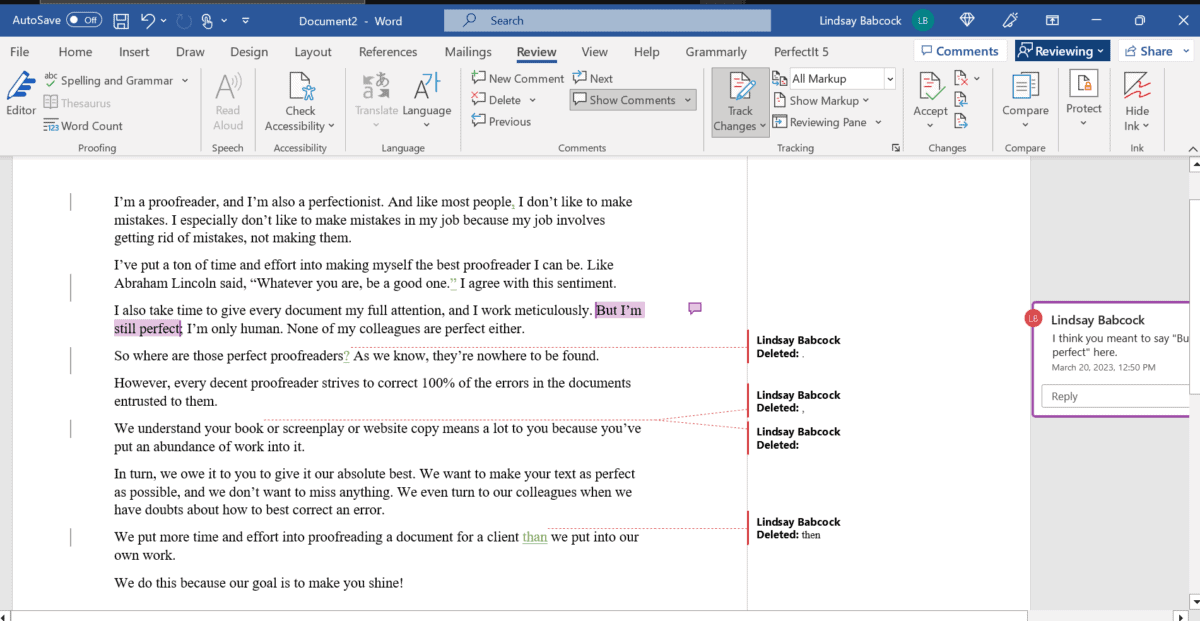
This is how it looks if you proof someone’s prose using the Suggesting feature in Google Docs.

However, many clients don’t want to bother accepting or rejecting changes. They want a “clean copy” of their writing with all the recommendations approved and integrated. I often get this request when I proofread someone’s work.
Now that we’ve learned what proofreading is and why this term causes confusion, let’s discover when proofreading takes place in the traditional four-stage editorial process.
Then, we’ll learn about the errors proofreaders are trained to find and correct.
Where Proofreading Fits into the Editorial Process

Since proofreading is often confused with other editorial stages, it’s helpful to know where it fits into the editing process.
The traditional editorial process consists of four stages: developmental editing, line editing, copyediting, and proofreading.
The process starts with developmental editing and ends with proofreading.
Let’s briefly look at each stage. You’ll notice some overlap from one step to the next.
1) Developmental Editing
Developmental editors (aka structural editors or substantive editors) work on the document as a whole, focusing on the following:
- Adding/deleting/reorganizing entire sections of text to improve the overall structure and content
- Ensuring the writing makes sense
- Checking that the writer has addressed all the main points
Note: For works of fiction, a developmental editor would consider several other factors, including character development, setting, plot, and pacing.
2) Line Editing
Line editors (aka content editors or stylistic editors) work on issues at the paragraph level as well as major issues at the sentence level, focusing on the following:
- Refining the language to improve clarity, flow, and consistency in tone and style
- Rearranging sentences within paragraphs if necessary
- Making sure the level of language is suitable for the target audience
3) Copyediting
Copy editors work in-depth at the sentence level on the following:
- Making writing correct, comprehensive, consistent, clear, and concise (the five c’s of copyediting)
- Correcting errors with syntax (sentence structure)
- Fixing mistakes with grammar, capitalization, punctuation, spelling, and formatting
4) Proofreading
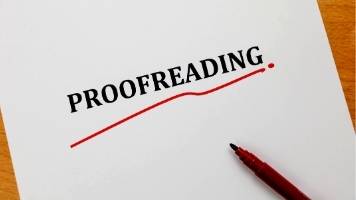
Proofreaders work thoroughly at the word level on the following:
- Fixing errors with grammar, capitalization, punctuation, spelling, and formatting
- Correcting improper word choices (affect vs. effect)
- Checking for repeated or omitted words
Proofreaders work with documents that have already been edited; these texts should be structurally sound, well written, and easy to follow.
The Difference between Proofreading and Editing
As we can see, proofreading and editing are two different processes.
While editing focuses on the big picture, proofreading deals with the details (e.g., spelling, grammar, punctuation).
Editing enhances a document’s organization and content, which can involve moving or deleting large chunks of text. Editors notify the author if any ideas or arguments need further development.
We can see why editing comes before proofreading. You would derive minimal benefit from hiring a proofreader before an editor since the editor would likely make substantial changes.
A proofreader can start working only after all the rewriting and tweaking have been completed.
Now let’s dive deeper into a proofreader’s job description.
What a Proofreader Does (Their Role on Error Patrol)
As mentioned, a proofreader’s job is to use their eagle eyes to find and correct errors that were missed during previous editing stages.
Proofreaders don’t improve the flow of writing or make it more concise.
And although they’re not responsible for fact-checking, they’ll alert the author to egregious errors.
Proofreading is a crucial step in the editing process because it serves as the final review of a document before it’s shared with readers.
The Main Kinds of Errors Proofreaders Look For
Let’s see specific slipups proofreaders strive to spot.
Proofreaders Guard against Grammar Gaffes
Grammar deals with the parts of speech and how they come together to form sentences. We have eight parts of speech in English: nouns, pronouns, verbs, adjectives, adverbs, prepositions, conjunctions, and interjections.
As you can imagine, we make a multitude of mistakes related to each of these parts of speech.
Here are a few examples of grammatical errors proofreaders look out for:
- faulty subject/verb agreement
- incorrect use of pronoun cases
- misuse of verb tenses
- using an adjective where an adverb is needed (and vice versa)
- wrong preposition choice
- mispairing of correlative conjunctions (e.g., pairing either with nor instead of or)
- inaccuracies with interjections
They Correct Capitalization Catastrophes
This category of errors is fairly straightforward. Proofreaders correct oversights dealing with the improper capitalization of nouns.
Some authors fall into what Rebecca Elliott calls the “cap trap” in her book Painless Grammar. This is when authors mistakenly capitalize words they deem important.
Proofreaders Pluck Out Punctuation Pitfalls
The most common mistakes here result from misusing periods, commas, semicolons, colons, question marks, exclamation points, hyphens, dashes, parentheses, quotation marks, and apostrophes.
Proofreaders also need to look for errors related to the treatment of numbers and abbreviations.
They Snuff Out Spelling Snafus
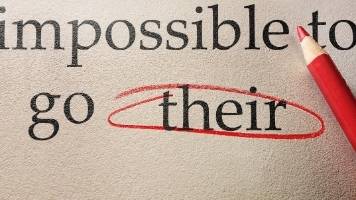
Proofreaders are responsible for finding misspelled words, including those overlooked by spellcheckers. Of course, a spellchecker can tell you if the author misspelled a word. But it can’t tell you if they used a correctly spelled word in the wrong context (e.g., discreet vs. discrete).
Another problem with spellcheckers is that they’re not always up to date with industry-specific terminology.
They Fix Formatting Fumbles
In this category, proofreaders keep their eyes peeled for improper spacing between elements in a text (words, sentences, paragraphs, headers, etc.).
They must also ensure that headings, subheadings, paragraphs, and lists are properly aligned.
Inconsistencies in font size or type are another common mistake to look for.
As mentioned, proofing a typeset text involves checking for many more formatting flubs.
Proofreaders Wipe Out Witless Word Choices
Word choice blunders tend to happen with homophones—words with the same pronunciation but different meanings (and usually different spellings).
Here are a few examples:
- bear vs. bare
- principal vs. principle
- to vs. too vs. two
- there vs. they’re vs. their
Of course, an author may simply choose a word whose meaning doesn’t make sense in a given context.
A common mistake for those who speak English as a second language is misusing prepositions. Proofreaders have to pick up on prepositions that pair poorly with other words.
They Remedy Repeated or Omitted Words
This category couldn’t be more self-explanatory. Sometimes writers repeat words, and and sometimes they leave out. 😉
Proofreaders Ensure Style Guide Rules Are Respected
We have style guides that govern writing in various fields.
Proofreaders are responsible for checking that writing adheres to the standards in the appropriate guide.
A style guide lays out standards for numerous components of writing, including the following:
- grammar
- capitalization
- punctuation
- spelling
- formatting
- word usage
- treatment of abbreviations and numbers
Here are four of the major style guides for content written in US English:
- The Chicago Manual of Style (used in book publishing)
- The Associated Press Stylebook (used in journalism)
- Publication Manual of the American Psychological Association (used in social sciences)
- MLA (Modern Language Association) Handbook (used in the humanities)
I use The Chicago Manual of Style for most of my proofreading work and as the guide for the content on this website.
New Hart’s Rules: The Oxford Style Guide is a popular guide for proofing UK English.
Following a style guide lets proofreaders know precisely how to correct a document and ensures they make corrections consistently.
Example: Consistency with Em Dashes
Regarding em dashes, The Chicago Manual of Style dictates that no space appears to the left or right of an em dash.
Here’s a sentence from earlier in this blog post that contains an em dash: “And when you see a page that ends with the first little part of a new paragraph—that’s an orphan.”
However, The Associated Press Stylebook calls for one space on either side of an em dash.
Therefore, a proofreader using The Chicago Manual of Style would delete any space they found on either side of em dashes throughout an entire document. However, if they followed The Associated Press Stylebook, they would ensure that all em dashes in a text had one space on each side.
Om Proofreading discusses style guides and how to use them if you’re interested.
They Detect Dialect Disturbances
We have several English dialects: US, UK, Canadian, and Australian.
Differences in spelling, vocabulary, punctuation, and grammar exist between these styles of English.
Therefore, any deviations in dialect need to be detected and marked as errors.
I published an article that gives specific examples of the mistakes proofreaders look for if you’d like to explore this topic further.
The Different Types of Proofreading
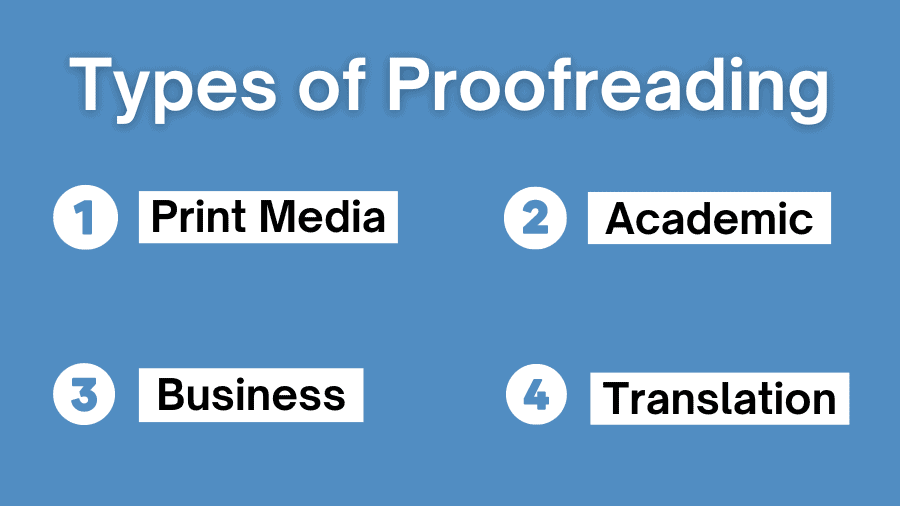
We can divide the types of proofreading into four categories: print media, academic, business, and translation.
Print Media Proofreading
Proofreaders of print media work for publishers or self-publishing authors.
Here are some examples of print media documents:
- books and e-books (fiction and nonfiction)
- screenplays
- newspapers
- magazines
Academic Proofreading
Academic proofreading involves polishing the writing of college students, researchers, and professors in academia.
Some examples of academic texts include the following:
- research papers
- theses
- journal articles
- personal statements
Business Proofreading
This kind of proofreading deals with tidying up the texts of business owners. We can also include job applicants here.
The following are examples of business writing:
- white papers
- PowerPoint presentations
- website copy
- cover letters
Translation Proofreading
Translation proofreading means proofing any text someone translated from one language to another.
Many documents fall under this category since we can translate practically any text into another language.
We can split translation proofreading into two categories: monolingual and bilingual.
Monolingual proofreaders know the language of the final document (target language) but not the language of the original text (source language).
Bilingual proofreaders understand both the target and source language.
The Skills Needed to Be a Proofreader
So what skills does a professional proofreader need?
A firm grasp of English grammar and mechanics is at the top of the list. But it doesn’t end there.
Proofreaders need to be familiar with at least one major style guide.
We have style guides for specific genres of writing. These guides provide rules to ensure the language and formatting of a text are clear and consistent, resulting in professional-looking content.
In addition to being familiar with style guides, proofreaders should know how to research using Google, the appropriate dictionary, and other relevant resources.
They’ll also need to know how to proofread in MS Word, Google Docs, and possibly Adobe Acrobat.
Of course, proofreaders must be patient and attentive to detail as they review writing with a fine-tooth comb.
The ability to stay focused for long blocks of time is also essential.
These eagle-eye workers need to have the self-discipline to stay organized and meet deadlines. They’ll also have to manage their time well and solve problems independently.
Finally, a robust general knowledge base and a willingness to keep up with changes to style guides, dictionaries, culturally acceptable language, and industry-specific terminology will serve them well.
Why Proofreading Is Important
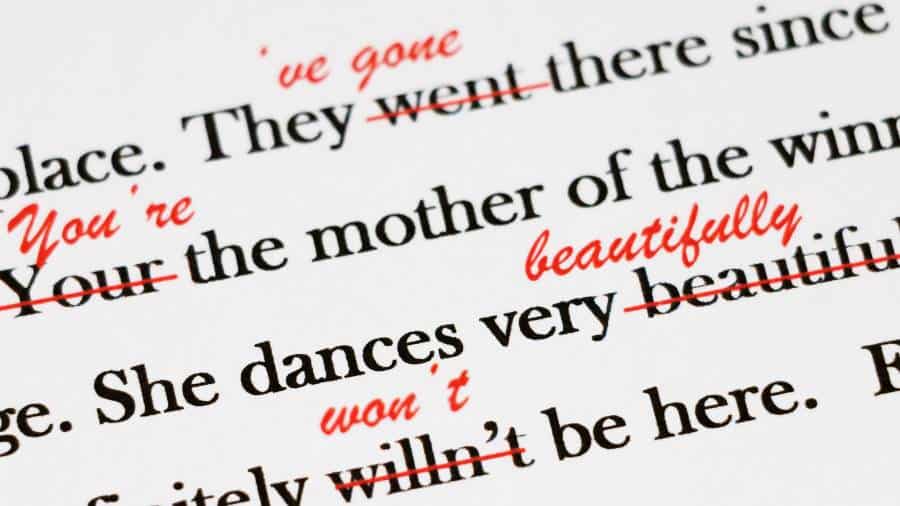
Proofreading is essential for many reasons!
Our written word reflects us and often serves as the first point of contact with other people.
For example, you’ve probably never met me, but the writing on this website represents me in my absence.
What if my writing was riddled with errors?
At the very least, you’d probably be annoyed. Worse yet, it could make you bounce from my website in search of someone who cared enough to polish their prose.
Of course, I’m far from perfect and make plenty of mistakes!
But I dedicate substantial time trying to make my content error-free—especially since this website focuses on proofreading!
Whether we like it or not, people evaluate us based on the quality of our writing.
Overlooked mistakes can muddle our message, make us look careless and unprofessional, and even call our credibility into question.
And just like people have little patience for slow websites (or slow anything these days 😉), they have a limited capacity for reading writing that causes them to trip over typos and stumble over sentences that are grammatically unsound or poorly punctuated.
Proofreading is crucial for job seekers to land work, businesses to attract clients, and students to get good grades.
I authored an article about reasons why proofreading is crucial that I think you may find interesting. The post contains a video about five of the worst typos in history.
Effective Proofreading Strategies
Certain tactics can help us find errors with increased accuracy and efficiency.
Let’s talk about three top-notch tips for proofreading.
1) Have the computer read the text to you out loud.
We need to use our eyes and ears for proofreading. When we listen to a piece of writing, it’s easier to catch omitted or repeated words. We can also sense whether something sounds a bit off.
Our ears can sometimes catch what our eyes miss!
2) Read the writing backward, one line at a time.
If you’re proofreading a short text, a tried-and-true strategy is to read it backward.
Starting with the last sentence of the document, go sentence by sentence—reading each sentence from left to right as usual—until you reach the first sentence.
Reading this way stops our brain from anticipating what will come next, forcing us to slow down and focus all our attention on one sentence at a time.
Just like we use mindfulness to stay in the present moment in life, we can use backward proofreading to keep our full attention on the sentence we’re reading.
3) Change the appearance of the document.
Altering the text’s appearance can convince our brain that we’re having a novel reading experience.
Perceiving the writing in a new way helps us spot errors we may have overlooked.
We can modify the writing by changing font size, style, or color. Making the font bigger is usually the best bet, especially for noticing problems with tiny punctuation marks.
We can also add space between lines or divide the text into two columns.
Just do what works best for you! 😊
I penned a post about valuable proofreading techniques if you’d like more tricks to kick those errors to the curb!
Frequently Asked Questions
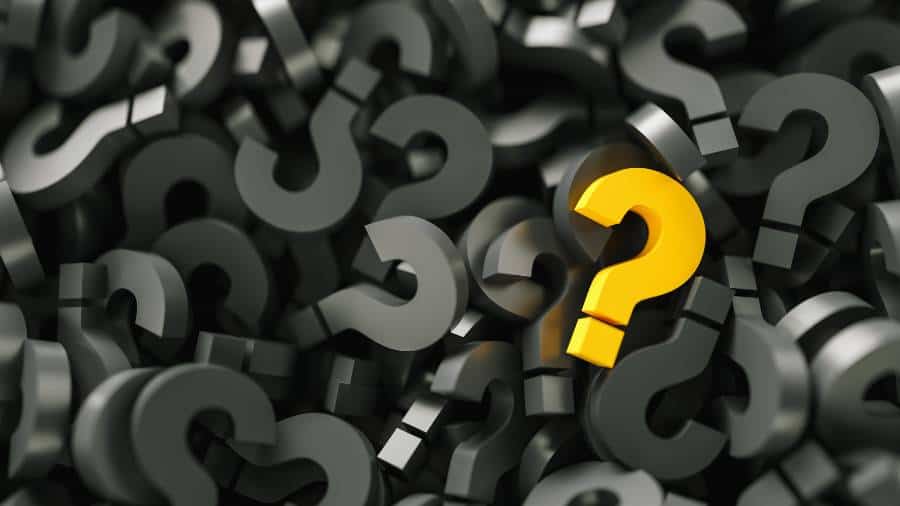
How much does proofreading cost?
Proofreading typically costs 1–3 cents per word if you hire a freelance proofreader and 3–6 cents per word with an online proofreading service. This translates to $10–$60 per 1,000 words. (One page contains 250 words.)
However, expect to pay more if you have a tight turnaround time, a poorly written document, or a highly technical text.
I wrote a post about proofreading fees and the pros and cons of choosing a freelancer over a proofreading company if you’d benefit from that information.
What are the best proofreading services?
Several reputable proofreading services are available. However, Cambridge Proofreading, ProofreadNOW.com, Editage, and Proofed are among the best online proofreading companies.
How do I find a good proofreader?
You can find proofreaders via Google, freelance platforms like Upwork and Fiverr, and online groups for writers and authors.
One of the best ways to know you’ve found a good proofreader is to ask them for a sample edit.
You can also inquire about the style guide they use and pay close attention to their written communication.
I talk about these methods and many more in my article about choosing a dependable proofreader.
How do I become a proofreader?
To become a proofreader, you’ll want to determine what kind of proofreading you want to do. Most people choose to do general proofreading so they can work on a wide range of documents.
However, some individuals decide to do transcript proofreading, meaning they only proofread court transcripts. Becoming a transcript proofreader takes much more time than becoming a general proofreader.
Then, you’ll want to take a well-respected proofreading course to learn the skills you need to succeed.
The proper skill set will allow you to be competitive in the market, acquire clients, and establish a good reputation.
I published a piece about getting into proofreading if you’re interested in learning more.
What software do proofreaders use?
Freelance proofreaders primarily work with Track Changes in Microsoft Word and the Suggesting feature in Google Docs. Both programs are easy for the client and proofreader.
Proofreaders who work on PDFs typically use Adobe Acrobat to mark up documents.
Grammarly and PerfectIt are two popular software programs that enable proofreaders to do their work more efficiently.
Om Proofreading has a post about the software proofreaders use if you’d like more information.
I hope this article has helped you better understand what proofreading entails.
Best wishes to you!
“You are not a drop in the ocean. You are the entire ocean in a drop.”
– Rumi
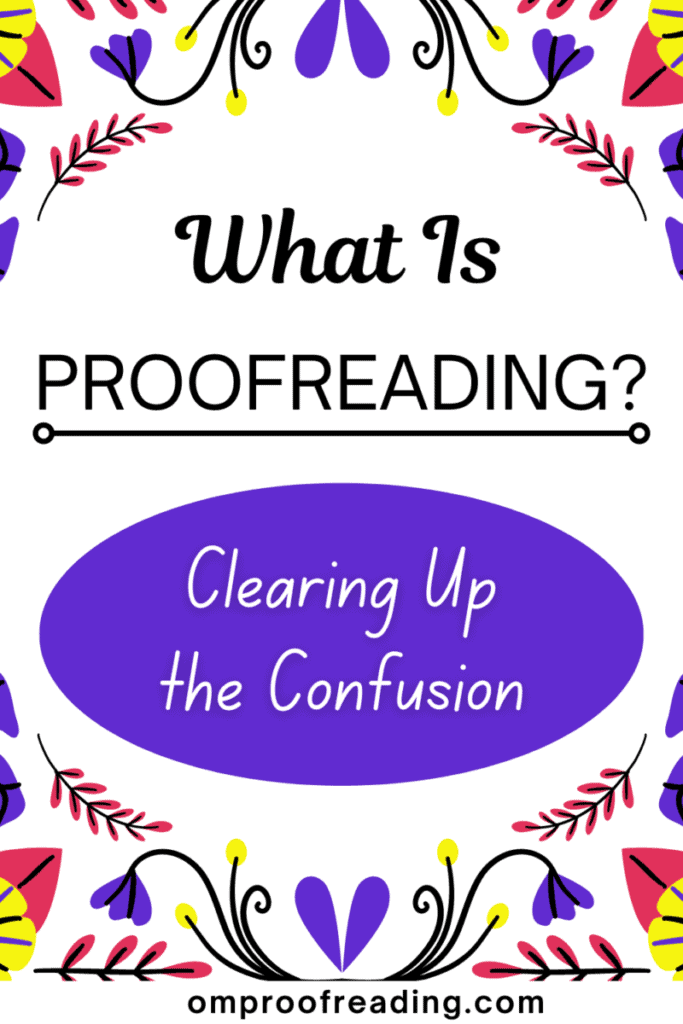
Recent Posts
Punctuation is important because it enables us to communicate our message clearly and effectively. Without punctuation, we wouldn’t understand how units of a sentence relate to one another or how...
Although you're probably somewhat familiar with adverbs, you may be unaware of sentence adverbs. As a trained proofreader who has studied the parts of speech, I can help you understand this unique...
